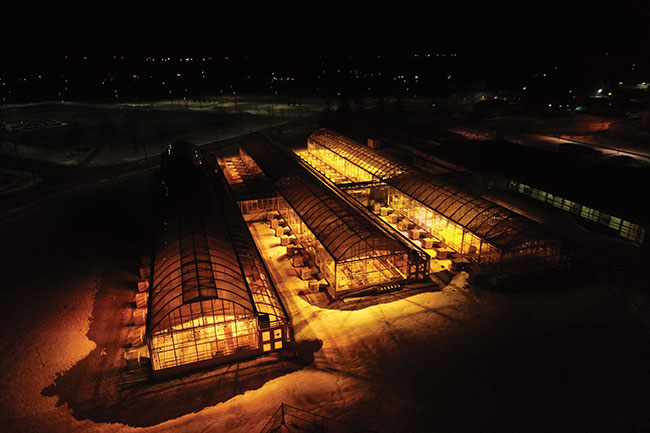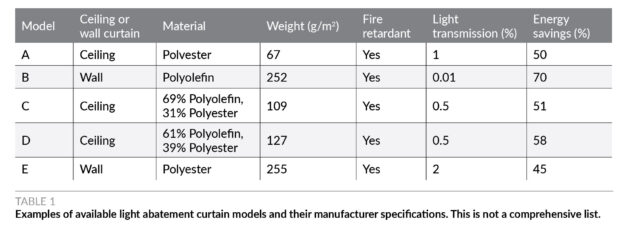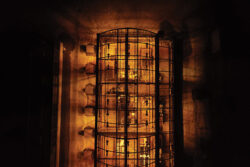
Features
Managing nighttime greenhouse light emissions
Without proper management strategies, light emitted from greenhouses during nighttime hours can potentially be disruptive to neighbouring residents.
December 14, 2022 By The Ontario Ministry of Agriculture, Food, and Rural Affairs
 Photos: Benjamin Snow, University of Guelph
Photos: Benjamin Snow, University of Guelph An increase in the use of supplemental lighting in greenhouses has been accompanied with an increase in the amount of light emitted from greenhouses at night during fall and winter months. Without proper management strategies, light emitted from greenhouses during nighttime hours can potentially be disruptive to neighbouring residents. As a result, the objective of this document is to outline the latest research in greenhouse light management for producers and to provide information on managing nuisance complaints should they arise.
- Highlights of greenhouse light management research:
While many studies have investigated the effects that different lighting strategies have on plant production, there has been little examination of light emissions from greenhouses. - The amount of light emitted from greenhouses using supplemental light is dependent on many factors including light abatement curtain use, crop stage, and light intensity (Snow et al.; 2022a, 2021a, 2021b).
- Sky brightness levels near greenhouses using supplementary lighting can be affected by light levels emitted from other sources in the region (e.g., infrastructure, industry, residences and businesses). Cloud conditions, air quality and moon phase also impact sky brightness (Snow et al.; 2022a, 2021a, 2021b).
- Research to determine optimal light management strategies for greenhouse production is ongoing, with the goal of developing strategies that create growing environments to support plant health, yield, energy efficiency and compatibility with neighbouring land uses.
Greenhouse light emissions
The amount of light emitted from greenhouses using supplemental lighting at night depends on light intensity, closure of light abatement curtains and amount of vegetation.

1) Light intensity of the fixtures installed in the greenhouse
In general, crops that produce fruits like high wire vegetables or large flowers such as cannabis require more light than potted ornamental plants or lettuce (Faust, 2021). The use of higher intensity supplemental lighting in greenhouses is associated with higher light emissions when light abatement curtains are not being used (Snow et al.; 2022a, 2021a).
2) Closure of light abatement curtains over the crop and on side and end walls
There are many models of light abatement curtains on the market that are made of different materials to suit the needs of greenhouse producers for managing the greenhouse environment for the crop (Table 1). These curtains reduce the amount of light emitted from greenhouses by reflecting the light back into the greenhouses. Current ceiling light abatement curtains allow less than 1% light transmission and wall light abatement curtains allow less than 2% light transmission when fully closed. This allows for greater use efficiency of the supplemental lighting since most of the light is contained inside the greenhouse to be used by the crop.
Light emitted from the sides and ceiling of greenhouses using supplemental lighting at night may impact neighbouring land uses. These light emissions can be minimized by using ceiling, side and end wall light abatement curtains. As ceiling light abatement curtains are opened to different gapping degrees (10%, 20% gapping, etc.), there is an increase in the amount of light emitted that is somewhat proportional with the gapping (Snow et al., 2021b).
Furthermore, light emitted from the top of greenhouses using supplemental lighting at night may be observed further from the source by artificially illuminating the night sky. These emissions can be reduced by using light abatement curtains over the crop. There may not be much change in sky brightness when fully closed light abatement curtains are opened to a 10% gap, but as light abatement curtains are fully opened there may be a significant increase in sky brightness near the greenhouse (Snow et al., 2022a).
3) Amount of vegetation in the greenhouse
More light is emitted from walkways and areas with less plant volume than areas in full production. This is most likely due to more light being reflected by surfaces than plants (Snow et al., 2022a).

Energy efficiency considerations
Curtains designed for light abatement (keeping supplemental light in the greenhouse) or blackout (keeping sunlight out of the greenhouse; typically used in cannabis or ornamental production) offer potential energy savings especially when used in combination with energy curtains as a double layer over the crop (Hanifin, 2022).
The use of light management curtains can impact the climate in the greenhouse, which in turn can negatively impact plant growth and yield. Therefore, it is important to research production practices and technologies that can address potential humidity and temperature concerns.
Strategies to maintain a consistent environment in greenhouses with deployed light abatement curtains are being researched (Nauta et al.; 2022). Using new technology, such as air-mix fans, may help growers maintain a consistent environment under light management conditions. Air-mix fans blend air from above light abatement curtains with air from below the curtains when curtains are fully closed. The cooler air above the curtains is pulled below the curtains and mixed with the warmer air to cool it down before being blown into the greenhouse. These fans are typically installed below the curtains with a duct leading through the curtain to the space above the curtains (Table 2). This technology may assist in maintaining a constant climate in a greenhouse where light abatement curtains are closed.
Dehumidification technologies may also provide additional climate control in the greenhouse and energy savings in the fall and winter months (Han et al.; 2021) or when outside ventilation is limited by curtain deployment. However, this needs to be tested in greenhouses with light abatement curtains.
Why is supplemental lighting necessary?

Overhead supplemental lighting is typically used to extend the day length in the fall and winter months, but it can be used year-round to increase the amount of light a crop receives.
Shorter days in the autumn and winter seasons and low light levels during cloudy days in the spring and summer seasons make the use of supplemental lighting necessary for the production of high-quality greenhouse vegetables, fruits, ornamentals, and other crops year-round in Ontario.
Greenhouse producers may use supplemental lighting throughout the year for a variety of reasons based on the crops they produce, such as:
- Supplemental light may be used to increase the amount and/or duration of light a plant receives during a day to ensure optimal growth. This can be achieved through day length extension by using lights before sunrise or after sunset. Lights may also be used during the day to provide increased light intensity on cloudy days or during sunrise and sunset.
- In ornamental and cannabis plants, supplemental light may be used to control flowering. Night interruption may be used to control flowering time in ornamental crops by providing a brief period of light during the dark/night period. Certain species of cannabis need a fixed light period to promote the transition from vegetative growth to flowering.
There are two common types of supplemental lighting used in greenhouse production. High pressure sodium (HPS) lights have traditionally been more popular, but the transition to more energy efficient light-emitting diodes (LED) is ongoing. LED fixtures also allow growers to use different spectrums of light to optimize how the plant develops, and the lower amount of heat generated by LEDs allows them to be placed closer to the crop, and where appropriate, within the crop canopy.
Supplemental lighting is most commonly delivered from above the crop with fixtures hung from greenhouse trusses. Overhead supplemental lighting is typically used to extend the day length in the fall and winter months, but it can be used year-round to increase the amount of light a crop receives. Intracanopy lights, which are placed within the canopy of vine vegetable crops like tomatoes, peppers, and cucumbers can also be used year-round to improve light delivery to shaded areas of the canopy where the plant develops fruit.
References:
- Faust, J.E. DLI Requirements for Various Greenhouse Crops. Ball RedBook. Volume 2: Crop Culture and Production. 19th Edition. June 2021.
- Han, J., J. West and A. Huber. 2021. Demonstration of Energy-Saving Dehumidification in Ontario Greenhouses. Canadian Greenhouse Conference. Poster presentation: October 6-7, 2021.
- Hanifin, R. 2022. Saving energy with curtains: A simulation exercise. Greenhouse Canada Magazine. January 11, 2022.
- Nauta, A., W.D. Lubitz, S.H. Tasnim, J. Han. Methodology and Validation of a New Interior Climate Prediction Model for Commercial and Small-scale Greenhouses. Proceedings of 2022 Responsible Engineering and Living Symposium. Windsor, Ontario Canada. June 23-24, 2022.
- Snow, B., W.D. Lubitz. 2022a. Progress Report: Greenhouse Light Emissions Survey. Light Management Research Advisory Committee. Presentation: June 1, 2022.
- Snow, B., W.D. Lubitz, S.H. Tasnim, T. Graham, D. Llewellyn, F. Al-Daoud, C. Dayboll.2022b. Comparison of the spectral and intensity responses of light sensors used to measure greenhouse light emissions. Presentation at 2022 Responsible Engineering and Living Symposium. Windsor, Ontario Canada. June 23-24, 2022.
- Snow, B., W.D. Lubitz, S.H. Tasnim, T. Graham, D. Llewellyn, F. Al-Daoud, A. Wylie. 2021a. Exploring Use of Drones to Evaluate Light Emissions from Ontario Greenhouses. Canadian Greenhouse Conference. Poster presentation: October 6-7, 2021.
- Snow, B., W.D. Lubitz, S.H. Tasnim, T. Graham, D. Llewellyn, F. Al-Daoud. 2021b. Experimental Measurements of Light Emissions from Ontario Greenhouses Using Supplemental Lighting at Night. 5th International Conference of the International Commission of Agricultural and Biosystems Engineering (CIGR). May 10-14, 2021.
Operators are encouraged to do their own research. Table 1 and Table 2 are not comprehensive in nature. No ministry or public sector agency has approved or endorsed any particular service provider or structural solution. Presence on or absence from this list does not indicate quality or reliability of the service provided.
Print this page